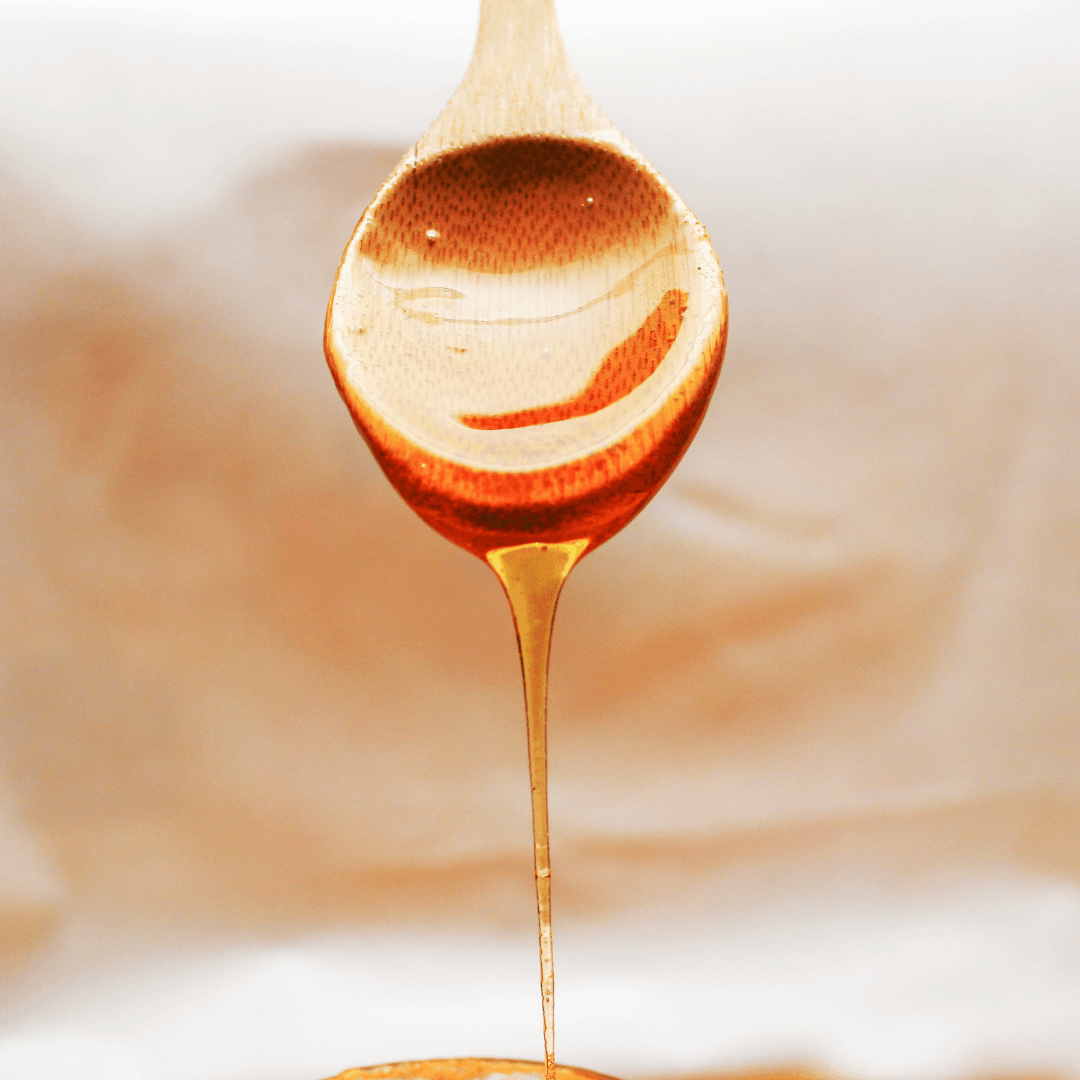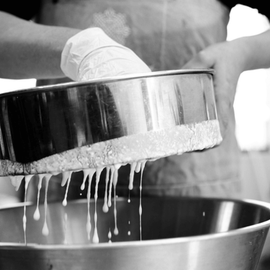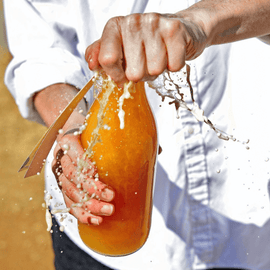Using honey to make mead has been my favourite discovery over the last few years. Without a doubt, it brings out the witch in me and I now have a rustic, porous wooden stick to stir and keep for each batch, hopefully transferring the yeasts and giving it a boost. There is a well-known garlic honey recipe in my book - I mention the fruits you can add in there and I think you should try it particularly while the summer fruits are abundant, but then again in autumn - persimmons, pomegranate, quinces and rhubarb all do well.
Garlic is the most well known and you ferment it the same as with the fruit. I usually have an older garlic in a jar of honey (it can be years old), and a younger one going. They young garlic is quite translucent, and the older the honey gets the darker, richer, deeper yet still sweet it becomes. Still tasting very much of garlic. It's fantastic drizzled over some blue cheese, any vegetable dish, potato and leek soup.... it's up to your palate to do the craving and find all of the ways to use it.
The honey is great as a throat soother - it obviously has all the wonderful properties of garlic so in particular we are grateful for this early winter. My daughter who studies opera is a huge fan. For the medicinal qualities we prefer the garlic infused honey young - at the 3 week to 3 month stage.
A good practice is to coat the garlic in way more honey than it needs so you can get both young honey from there, and have enough honey left to age the garlic.
If you make this, you will use it as cough medicine or on sore throats.... I recommend adding some nigella seeds, and a sprig of thyme to this for a potent healer.
(Here is the recipe - only 1 direction... simple as that. x)
How to:
- Wash your fruit and pat dry (I usually leave peels on), or peel your garlic - depending on what you're fermenting.
- Place in a very clean jar.
- Pour raw honey over this, leaving a quarter of the jar as head room.
- Seal with clean lid and if you're not using an air lock system, place the jar on a little plate and make sure to burp now and then.
- For the first week, every time you walk by your jar, give it a tip - like a snow globe - to make sure the fruit is covered, and also so you can enjoy watching the honey get thinner.
- Ferment for as long as you like, tasting along the way.
Eat or Drink like this
EAT: I like pouring the fruit honey, the flavours of summer on creamy porridge in the winter. Blueberry, nectarines, blackcurrants, plums with anise for example). If the syrup is strong enough I add it to milk kefir and stir it in to flavour a glass of that. YUM. You can drizzle fruit honey over pancakes, scones, toast, cakes...cream cheese, you'll find lots of places for it.
The garlic honey, is a bit different. The garlic will quickly become like a lolly - chewy, sweet and not too pungent. You can pull these out one at a time, to eat when you feel a cold coming on - or to chop or slice over soft cheese, labneh, they'd be great in a nut cheese too or over a bowl of ramen, or fried chicken or tofu. The liquid will be gold for you - drizzle wherever you can imagine a sweet garlicy hit, adding to marinades too. But this also comes into your life by the teaspoon the minute you feel yourself coming down with something.
DRINK: Make a wild fermented soda with by using a ratio of 1:5 of your honey ferment to water, and letting the lidded bottle sit out on the shelf for a few days. If you are interested in making herbal medicines this is a good time to look into what you'd like to use for that; a piece of dried burdock, a slither of ginger, I think getting hold of some adaptogenic dried mushrooms could be a good add as well. Hey and don't forget you can use it to sweeten tea!
Find similar articles
HoneyYes. Prevention is by frequent “burping” the jar. Minimum once every day while fermentation is very active. Also, when fermented to your liking, refrigerating helps keep it “tame”.
The same happened to me…it shot off like a champagne cork. I had two other jars, with jalapenos. The first one had seared Serrano peppers.. I’ve made this before at work regularly, lol it’s my job, but never had this happen. I’m wondering if it’s because I kept the tray by my stove, and also my house is significantly warmer … It probably got above 74° but wanted to ask someone more experienced. I’m new to fermenting and I love it. Made some successful vinegars using honeysuckle and squash blossoms, and all types of fruit fermented honey but they just didn’t work at the house! Ah well, learning experience. But what’s your thoughts? They sat for 8 days, I flipped each jar every day.
You can prevent ‘exploding’ jars by opening them every for about 10 days to let the air bubbles escape. You’ll know when to stop when there’s no more bubbles in the jar. Then leave the jar alone till you want to eat some! I’ve got jars of honey fermented veg in my cupboard for about a year now with no problems!
I think probably you need to burp it every few days or so, so the pressure doesn’t build up. This is true when you make kombucha and other fermented drinks.
@craig jamieson open your jar daily to burp it, it won’t explode if you let out the extra gasses. I hope this helps 💜
I did fruit with honey and bottled it but when I opened the lid few weeks later the lid shot off and the liquid went everywhere. I’d there a way to prevent this?



Comments